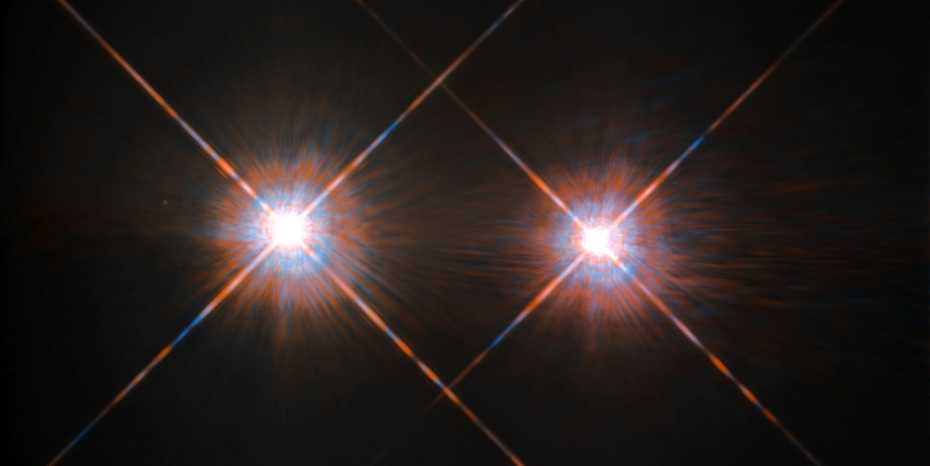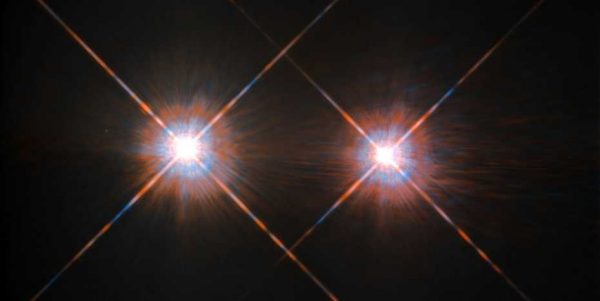Imagining an Earthly neighbour

We do not yet know whether the Sun-like stars closest to us, the α Centauri A/B binary, harbour an Earth-like planet. However, thanks to new modelling work, we now have a good sense of what such a planet, should it exist, would look like and how it might have evolved.

α Centauri A (left) and α Centauri B viewed by the Hubble Space Telescope. At a distance of 4.3 light-years, the α Centauri group (which includes also the red dwarf α Centauri C) is the nearest star system to Earth.
(Image: ESA/Hubble & NASA)
Text by Andreas Trabesinger
These are exciting times for exoplanet research, moving from demography towards detailed characterization. The James Webb Space Telescope (JWST), successfully launched in December 2021, is projected to detect the atmospheres of rocky exoplanets transiting within the ‘habitable zone’ in front of M dwarfs, stars that are fainter than the Sun. The Extremely Large Telescope (ELT), currently under construction in Chile, will be set up to directly image rocky exoplanets around nearby Sun-like stars by the end of the decade. Looking even further ahead, ambitious future space mission concepts are currently being explored, including the Large Interferometer for Exoplanets (LIFE), which targets habitable-zone rocky exoplanets and their atmospheres. ETH Zurich is leading or significantly involved in these and other observational infrastructures. Complementary research at the Institute for Particle Physics and Astrophysics concerns numerical modelling, which is indispensable for understanding habitable-zone rocky exoplanets and in guiding the future observations and instrumentation development. Now an international team led by ETH scholars present the results of such a study, in which they directed their attention to the Sun-like stars nearest to Earth, α Centauri A and α Centauri B. Reporting in The Astrophysical Journal, they provide a benchmark prediction of what an Earth-sized planet, should it exist in this system, would look like.
A hypothetical α-Cen-Earth
The team, which includes ETH astrophysicists Haiyang Wang, Sascha Quanz and Fabian Seidler as well as Paolo Sossi at the Department of Earth Sciences, set out to estimate the elemental composition of a hypothetical rocky planet in the habitable zone of the α Centauri A/B system. Their modelling is based on the spectroscopically measured chemical compositions of α Centauri A and α Centauri B, for which a breadth of information is available for both rock-forming elements (such as iron, magnesium and silicon) and volatile elements (including hydrogen, carbon and oxygen). From these data they were able to project possible compositions of a hypothetical planetary body orbiting either of the stars. In this way, the researchers arrived at detailed predictions regarding the properties of their model planet, which they dubbed ‘α-Cen-Earth’, including its internal structure, mineralogy and atmospheric composition. These features, in turn, are of central importance to understanding its long-term evolution and potential habitability.
With this work, Wang and colleagues have begun painting a captivating image of a potential exoplanet orbiting α Centauri A/B. If it exists, α-Cen-Earth is likely to be geochemically similar to our Earth, they predict, with a mantle dominated by silicates, but enriched in carbon-bearing species such as graphite and diamond. The capacity for water storage in its rocky interior should be equivalent to that of our home planet. According to the study, α-Cen-Earth would also differ in interesting ways from Earth, with a slightly larger iron core, lower geological activity, and a possible lack of plate tectonics. The biggest surprise, however, was that the early atmosphere of the hypothetical planet could have been dominated by carbon dioxide, methane and water — similar to that of Earth in the Archean eon, 4 to 2.5 billion years ago, when first life emerged on our planet.
The star–planet chemical connection
The study stands out in that it includes predictions about volatile elements on a rocky exoplanet. While it is well established that the chemical composition of ‘terrestrial’ planets (which are made up predominantly of rock and metal) generally reflects that of their host stars, this is true only for so-called refractory elements; that is, the main constituents of rock and metal. The correspondence breaks down for volatile elements — those that readily vaporize. This class includes hydrogen, carbon and nitrogen, which are key to understanding whether a planet is potentially habitable.
During his doctoral research at the Australian National University in Canberra (supervised by Charley Lineweaver and Trevor Ireland, who are co-authors of the new paper), Wang developed the first quantitative model that connects the chemical compositions of Sun-like stars and any rocky planets that surround them, for both volatile and refractory elements. Wang joined the Quanz group at ETH Zurich in 2019, where he has since developed the applications of this model further. More sophisticated models of the chemical relationship between star and planet are being developed in the group as well, through collaborations within the framework of the National Centre of Competence in Research PlanetS.
Window of opportunity
The probability of actually finding an older sibling of our Earth — the α Centauri A/B system is 1.5–2 billion years older than the Sun — could hardly be more favourable. From 2022 to 2035, α Centauri A and α Centauri B will be sufficiently separated to benefit the search for planets around each of the stars thanks to reduced light contamination from the other. Together with the new observational power that can be expected in the years to come, there is legitimate hope that one or several exoplanets orbiting α Centauri A/B will join the nearly 5,000 exoplanets that have been discovered since 1995, when the University of Geneva astrophysicists Michel Mayor and Didier Queloz (who joined the faculty at ETH Zurich last year) announced the discovery of the first planet outside our Solar System orbiting a Sun-like star — for which they were awarded the 2019 Nobel Prize in Physics, shared with the Canadian–American cosmologist Jim Peebles.
The work of Wang et al. provides a benchmark study for the field of exoplanet research, in terms of a detailed theoretical characterization of (hypothetical) habitable-zone rocky exoplanets around Sun-like stars in the solar neighbourhood. This is important in guiding future observations of such planets and in therefore maximizing the scientific return from the unprecedented, ground- and space-based astronomical infrastructures being developed. With all of this capability in place, we can look forward to a new chapter in discovery of planets and life in the cosmos.
Reference
Wang HS, Lineweaver CH, Quanz SP, Mojzsis SJ, Ireland TR, Sossi PA, Seidler F, Morel T: A model Earth-sized planet in the habitable zone of Centauri A/B. Astrophys. J. online 10 March 2022. DOI: 10.3847/1538-4357/ac4e8c Preprint: arxiv:2110.12565

